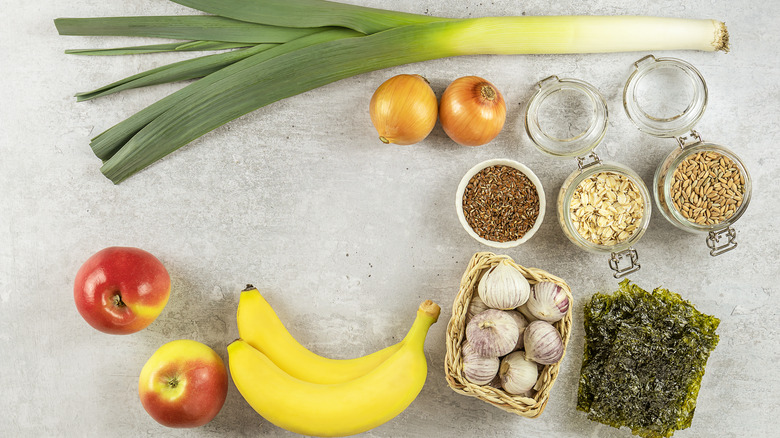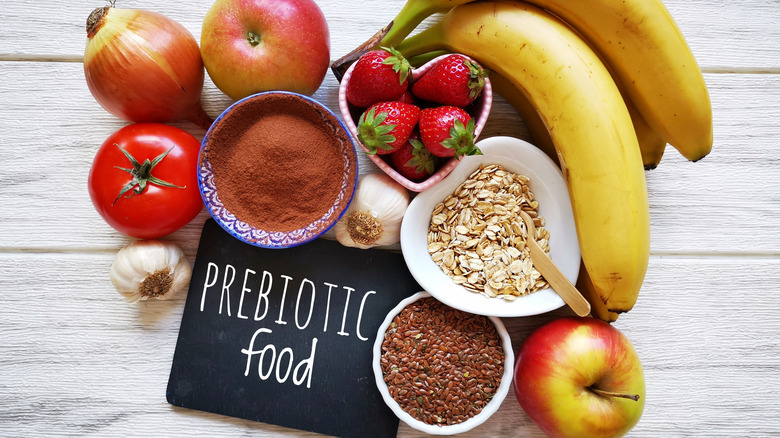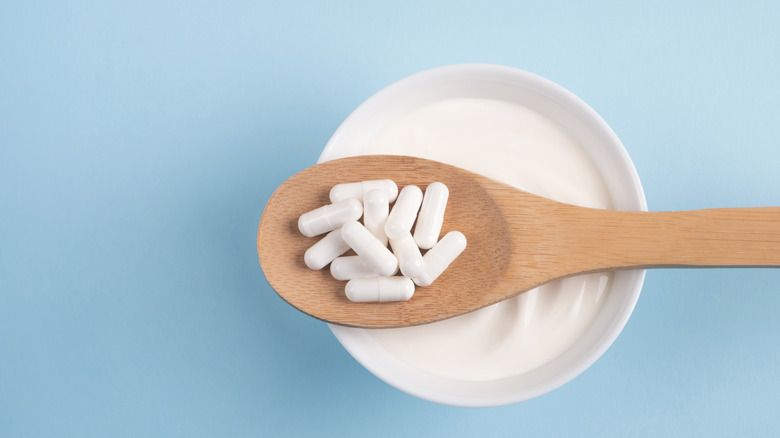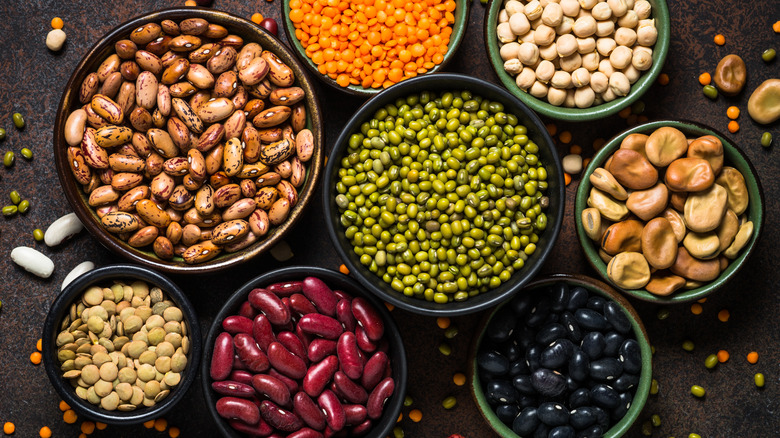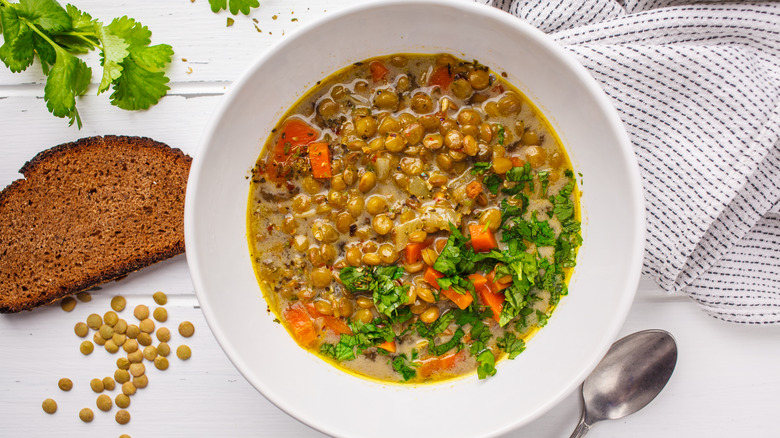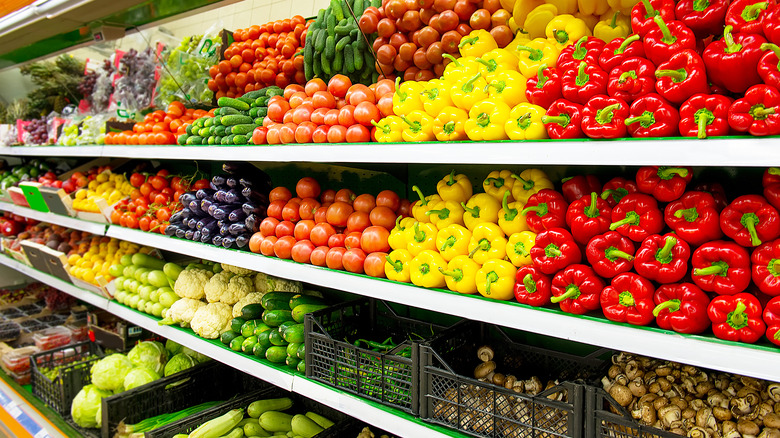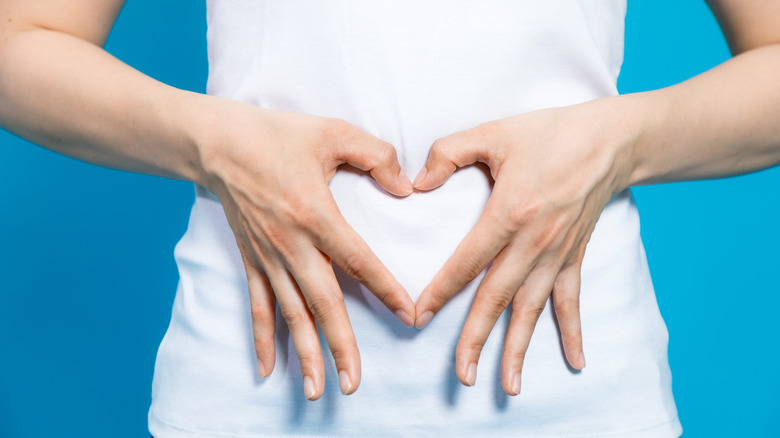What Are Prebiotic Foods And Why Should You Eat Them?
Not to be confused with probiotics, the term prebiotics is also becoming one of those increasingly buzzworthy words describing a category of foods revered for their inherent nutritive qualities. Unfortunately, most foods don't come labeled with a giant prebiotic sticker indicating their supposed superpowers, which would make them easier to discern. But the good news is, prebiotics can also come in a supplement format that makes them even more convenient, as seen on Very Well Fit.
So what are they? In short, prebiotics are organisms that can aid in producing a healthy gut microbiome, which, when balanced, can have great health benefits, says Mayo Clinic. If it sounds familiar, it's good to know that prebiotic foods have different sources and purposes compared to their relative, probiotics, adds the source. It's not a matter of disregarding one for the other, however, as the two are very much complementary, and you'll want to find ways to incorporate both elements into your diet.
But, don't worry, there is a wide variety of options to obtain prebiotics, and you might already be including some of them in your meals. Although supplemental sources can offer quick and easy ways to obtain these components, a healthy and diverse diet can also easily do the trick.
What are prebiotic foods?
Healthline explains that prebiotic foods contain a type of fiber that our bodies don't actually digest. (While all prebiotics are made of dietary fiber, the Dietary Guidelines for Americans Committee points out that the reverse is not true, per Nutrients.) According to EatThis, NotThat!, there are three main categories of prebiotic foods: Resistant starches, soluble fibers, and polyphenols. More specifically, the source lists that these classifications include foods such as oats, beans, legumes, alliums like scallions and leeks, certain fruits and vegetables, nuts, seeds, tea, coffee, and cocoa.
Here's how they work. Since the fibers in prebiotic foods remain undigested, they pass through the small intestine into the large intestine, where, as Food Network reports, they start to ferment. The source indicates that, if the conditions are right, the fiber transforms into short-chain fatty acids. In turn, these fatty acids then have a number of beneficial characteristics for the gut and body.
Additionally, prebiotic foods are actually a source of nourishment for the healthy bacteria that are in your digestive tract already, says Healthline. These good bacteria are none other than probiotics, aka the live organisms contained in certain types of foods. Food Network points out that different types of prebiotics are best suited to feed certain probiotics, indicating that variety in your diet is key for optimal balance. On the contrary, when you eat high-fat and high-sugar foods, you are actually feeding less desirable bacteria. But foods that are high in prebiotic fiber help to fuel the good bacteria, allowing them to flourish and replicate, according to Food Network's article.
Prebiotic vs. probiotic foods
Thanks to some unoriginal naming, prebiotic and probiotic foods are easy to confuse. Given the fact that both are often recommended as supplements or splashed across labels, it is hard to separate one from the other. As Healthline explains, for ideal gut balance, both prebiotics and probiotics are required. The prebiotics ultimately feed the probiotic bacteria so that they can grow and flourish in a healthy manner in your gut.
To help distinguish the two, it's helpful to know that probiotics are live bacteria that are found in certain foods and regularly in supplements (via Healthline). For example, fermented foods and yogurt with live cultures are prime sources of probiotic bacteria. Once these settle into the digestive tract, they need to receive nourishment in order to thrive. Prebiotics do the trick through their dietary fibers — these are found in a range of starches, grains, fruits, vegetables, nuts, and seeds, per Healthline.
A good rule of thumb is consuming a variety of nutrients to provide a broader profile of bacteria for healthier gut function. So, instead of focusing all of your energy on finding adequate sources of either prebiotics or probiotics, your best bet is to increase both.
What do prebiotic foods taste like?
Unlike some probiotic foods, which undergo fermentation and are filled with active live bacteria that can greatly impact the flavor profile, prebiotics are fairly standard and neutral in taste. The list of items that contain prebiotics is extensive and encapsulates diverse foods such as garlic, asparagus, oats, and bananas. Consequently, there is no defining flavor to identify prebiotic foods, which makes it easy to integrate so many of them into existing meals. Want something sweet? Make some banana bread. Craving a hearty entree? Cook up a sauté with garlic and veggies. Simply adding a few key ingredients like these to your dishes will significantly increase the level of prebiotics you intake while infusing layers of flavor.
Since prebiotics contain plenty of undigestible dietary fibers, aka bulk, the group often includes starchy and fibrous options. Indeed, the types of foods that are often considered to be for health nuts (seeds, nuts, whole grains, roots) are generally high in prebiotics. All the same, within the overarching category, you'll also find berries, cocoa, and tea, a good example of the diversity to be found with prebiotic foods. People following vegan or vegetarian diets will also have no trouble consuming suitable quantities of prebiotic foods.
How to cook with prebiotic foods
Thanks to the wide diversity of prebiotic foods, there is a lot that can be done with them in the kitchen. A great way to guarantee you'll get a hearty dose of prebiotics is to use garlic and onions as a base for sauces, stews, soups, and vegetable-based dishes. Not only do these ingredients provide plenty of aromatic flavors, but they also contain good amounts of prebiotics, according to Healthline. While you're at it, be sure to incorporate legumes, leafy greens, and your favorite vegetables to get the maximum benefit.
Whereas probiotics are sensitive to changes in temperature since they contain live bacteria, prebiotics are less fragile. Food Revolution Network indicates that the latter retain their qualities whether they are consumed raw or cooked, although some vegetables fare better uncooked. Funny enough, EatThis, NotThat! explains that eating cold leftover grains is more beneficial than when they're piping hot since they contain higher levels of resistant starches, aka prebiotics. On the same note, sushi definitely gets a thumbs up for this purpose.
You don't have to add all of these prebiotic sources into your diet at once — nor will your body appreciate it if you do. Due to the elevated fiber content, introducing them slowly with plenty of water is the best way to avoid gut discomfort and get the maximum benefits.
Where to buy prebiotic foods
A huge bonus when it comes to including prebiotic foods in your diet is that you don't need to search for one specific item in grocery stores. Since prebiotics encompass a range of foods, you can pick and choose what you want to add to your diet based on your taste and what's available. To start, keep a selection of grains on hand, and start adding a variety of beans and legumes to your shopping list. You can find these in the dry foods section, or you can buy legumes in cans for a simple and shelf-stable option.
Then, throw in some seasonal fruits and vegetables, and be sure to always have onions and garlic on hand to use when cooking. Remember, your gut will thank you twice as much if you pair these foods with probiotic options since the two make the ultimate duo for a healthy microbiome. While supplements for both can be purchased, Food Network recommends obtaining prebiotics directly from foods when possible. Once you get the hang of identifying foods high in prebiotics, it shouldn't be hard to get your daily fix.
Nutritional information about prebiotic foods
Since the effects of consuming prebiotics tend to ignite a chain reaction of beneficial results, it's not always the simplest to pinpoint the direct mechanism. Nevertheless, as mentioned, the still undigested prebiotics begin to ferment when they reach the large intestine. Healthline explains that as prebiotics mingle with probiotics in the large intestine, they transform into short-chain fatty acids. Foods Journal published a report in 2019 indicating that these acids then find their way into the bloodstream, which may reduce inflammation and might positively affect bodily functions.
In turn, Healthline notes that these acids may help strengthen the colon wall, which ultimately helps keep the bad bacteria from crossing through into the bloodstream. Nutrition coach Irena Macri remarks on her blog that this assists in an overall healthier functioning of the immune system. Macri adds that these fatty acids that are produced help regulate electrolytes in the gut and also improve the absorption of minerals from food. This finding was further reported in a research study published in Current Developments in Nutrition in 2018, which additionally demonstrated that an increase in prebiotic consumption helps avoid certain allergic responses.
As a result of the highly connected systems at play, Healthline notes that prebiotics may also be able to contribute to weight loss, blood sugar regulation — and beyond the physical, may even reduce effects of depression. Nature published the results of a 2021 study in Scientific Reports, which found a connection between higher prebiotic consumption and decreased anxiety, too. That's not to mention the vitamins and minerals you'll also reap from these healthy foods that are high in prebiotics.
All together, there's a strong argument for including more prebiotics into your diet, especially when it's so easy to do!
